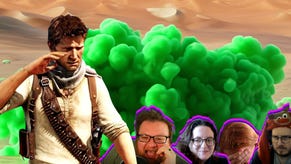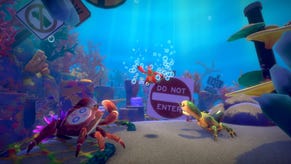Monster Hunter World: Iceborne Postmortem: The Making of the Expansion and the Future of the Series
We talk to Capcom about the challenge of making new monsters, future events, and that wonderful Palico grandmother.
This article first appeared on USgamer, a partner publication of VG247. Some content, such as this article, has been migrated to VG247 for posterity after USgamer's closure - but it has not been edited or further vetted by the VG247 team.
Online games don't have the greatest track record in 2019. Ghost Recon Breakpoint was a bust; Anthem was a disaster, and Fallout 76's new subscription plan wiped out a year's worth of accrued goodwill in less than a day. That makes Monster Hunter World: Iceborne a pleasant surprise—an expansion met with almost universal praise.
For its two month anniversary, we caught up with three of Monster Hunter: World's major developers: Director Daisuke Ichihara, art director Kaname Fujioka, and producer Ryozo Tsujimoto. We talked about the expansion's conception; future online events, and the origin of that wonderful Palico babushka. Here's what they had to say.
The Conception of Monster Hunter World: Iceborne
Monster Hunter World: Iceborne was a major departure for the series. The first thing I wanted to know was why Capcom decided to break tradition and develop a full-blown expansion.
USgamer: Iceborne was a massive undertaking with a lot of content. As this is your first experience with an expansion like this (versus a standalone game like Monster Hunter Generations Ultimate), I'm wondering what lessons you learned from the experience. Is this the right approach for the series going forward?
Ryozo Tsujimoto, Producer: We decided to release Iceborne as an expansion because the rate of online connectivity is high and we wanted to make sure both World and Iceborne players could play together, so that was something we really worked hard on. We also wanted to provide purchase options for players in different situations, so we prepared various product offerings for both physical and digital versions. This required hard work in its own way, in a different way from development.
What were the most successful events in Monster Hunter World, in your opinion? How will you apply them to Iceborne?
RT: We believe that Kulve Taroth had positive feedback from players. We hope to deliver something like that in the Iceborne updates as well to bring different gameplay dynamics.

The Old and New Characters of Iceborne
The Handler was one of the breakout stars of Monster Hunter: World, and in many ways she was the star of Iceborne as well. I wanted to know more about her development, but I also couldn't help asking about about another character who is original to Iceborne—maybe my favorite character of them all.
The Handler has a big role in Iceborne's story. How did you want her to grow in this story? What is strong about her character in your opinion?
Kaname Fujioka, Art Director: The main character (your hunter) of the Monster Hunter series is an avatar, so we avoid adding any animation or having them talk as much as possible as that would influence the avatar's personality. Because of that, it is necessary to have a role that speaks for the main character and leads the player so that they don't get lost. I think that the Handler's role and curious personality work well together and have helped her become a strong character.
I wanted her to feel the joy of believing in her teammates as they explore and face challenges together. When she landed on the new continent, she was more curious than anything. However, throughout the World story, she encounters different people and events. Then with Iceborne, she began to face the challenges passed on to her by her grandfather. She gains connections, the trust of others, and comes to understand the true meaning of the message from her grandfather. One of the themes of Iceborne is about the next generation taking over that which has been entrusted to them by the previous generation. Like this concept, we think that she was able to grow by receiving words from her grandfather.
I love the Palico grandmother who prepares your meals in Iceborne. Is she based on any particular experiences?
KF: My hometown is very cold in winter, so I always felt that my home, where my family would gather, was warm and relaxing. Since Iceborne was going to be based in a cold region, we wanted the canteen to give a similar warm feeling for the hunters. We thought that stew would be a good dish to warm the body and mind in cold regions. The thought process was a bit of a word association game where I thought warm, stew, Russia. Then realizing Russia is actually more known for borscht and not stew. But thinking of Russia got me thinking of matryoshka. All this resulted in us creating a warm space by combining all these different elements, and the chef adopted a cute round silhouette like matryoshka.
On Creating the New Monsters, Weapons, and Encounters
Monster Hunter World: Iceborne included a number of new monsters, but like other games in the series, also leaned heavily on older designs. Monster Hunter: World was criticized for its relatively low number of monsters, so that made me wonder how much time and effort it takes to actually create a new creature. I asked about that, as well as the effort that went into creating Iceborne's new weapons, and a key encounter in the latter portion of the game. Here's what the team had to say.
What are some key considerations when developing a new monster? How long does it take?
KF: When considering the look and personality of the monsters, what is important is whether the gameplay matches the design. First, we think about where in the game's progression the monster appears and what experience you want to give the player at that point. For example, whether you want a monster to appear as an action tutorial at the beginning of the game, or if you want the player to consider their current skill and armor sets more after getting used to the combat.
After considering the monster's "role," we start thinking about its movement speed, attack patterns, and what skeletal structure it will have based on what animal would best convey these elements. In addition, we incorporate ideas that will make the monster unique. The monster's behavior is extremely important as a representation of the game because it serves as a key for players to develop in-game strategies. We make sure we design in a way so that players will understand what the strategic points are and what we would like the players to watch out for when fighting a monster.
The time involved to develop varies from monster to monster. It could take us more than half a year for those monsters that need a lot of technical work and research, while others can be quicker if there is some kind of foundation available already.
Iceborne puts its brand new monsters at the beginning and at the very end, but the middle mostly has returning monsters from older games. Why did you go with this structure?
Daisuke Ichihara, Director: Iceborne's Master Rank is a level that is positioned above High Rank. New monsters that appear in the early stages of Master Rank are meant to convey the overall difficulty, as well as teach players how they should be approaching these enemies. Returning monsters cannot assume this role (because their roles are already defined from previous games in the series). We structured the game this way so that players are well prepared before they face off against the popular returning monsters.
The same goes for the final portion of the game. We introduced new monsters at this point to help players face the challenges of crafting Master Rank weapons and armor sets, as well as give them a sense of accomplishment that comes with finishing the game.
Since Monster Hunter: World is in HD, how much harder is it to develop new and interesting-looking weapon designs?
KF: There are many things that need to be considered from the concept phase, as the textures of the materials and the components are more clear in HD. It's not just about the silhouette and the details of the weapon, but also what functionality it has, what it's made of, and what kind of texture it has.
On that note, some feel Master Rank weapons look very similar to High Rank weapons. Why did you take that approach?
KF: We decided to introduce a system where some weapons are a combination of a weapon base and monster parts. We decided to utilize this for some weapons because we wanted users to enjoy the customization elements we added as part of the endgame content.
There's a multi-part setpiece where you fight the Velkhana as it invades your base. Tell me about developing that setpiece. I liked the way that the cannons were automated this time.
DI: There were two reasons for creating it this way: one was to construct a story with Velkhana, which is the main monster of the game and then second was game structure. In terms of the game structure, we wanted to plant some ideas in players' minds along the way on how to strategize fighting against Velkhana.
In the first battle at the Elder's Recess, Velkhana shows itself without ice, and only shows its basic moves. Here you will be able to learn the basics of dealing with Velkhana. In the second battle at the Seliana Supply Cache, Velkhana has its ice on, and unleashes all of its actions. You can observe and test out strategies, and the battle is cleared by using the weaponry that is available in the area. The third battle is where we would want the player to take on the challenge of defeating Velkhana based on what they've learned from their prior battles.
In World, the battle against Zorah Magdaros was at the base, and what we would like the players to experience this time is different from Zorah's battle. This time, it's more about observing and trying out different actions, so the priority on the area's weaponry is not as high in the Velkhana battles.
In the wake of its release, Monster Hunter World: Iceborne can be considered a success, selling some 2.8 million copies worldwide. In the meantime, the base game sits at about 14 million copies sold. The PC version of the expansion is due January, which should give it another injection of sales.
But despite being one of the bestselling releases in Capcom history, and being a relatively stable online platform to boot, it seems unlikely that we'll see another Iceborne. "Currently we don't have any plans to release another expansion like Iceborne for World, but we plan on adding free updates that would include monsters like we did with the original game," Tsujimoto says.
After the release of the PC version, Capcom will continue supporting Monster Hunter: World with crossover events and other online content. As for what the future holds, Capcom has long had a strong relationship with Nintendo. Perhaps the Switch will receive a full-blown sequel; one that will allow it to become a fully portable series once more.
Either way, there will be a lot more Monster Hunter where that came from. And it could be happening sooner than you think.










.jpg?width=291&height=164&fit=crop&quality=80&format=jpg&auto=webp)


